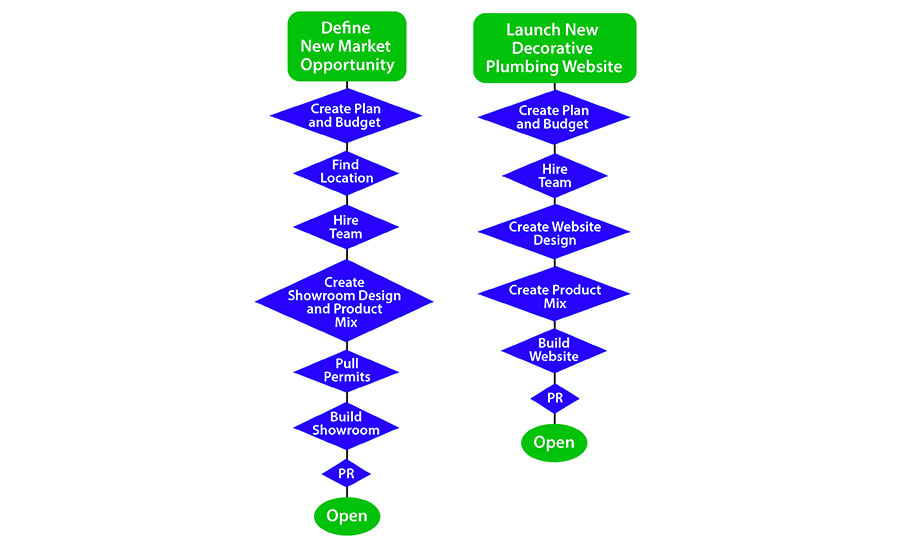The internet is just as accessible to a builder with an office one block from your showroom as it is for a builder hundreds of miles away. Popular e-commerce sites do not think of regional boundaries when they create business plans. These digital companies focus on market segments that can be located anywhere — anywhere the internet reaches.
What is so amazing about the internet is that it scales for free and there is no real limit to where it can take your brand. If you set up your site laser focused on sharing decorative plumbing information, stories and products and commit similar resources as you would to one showroom, your opportunity is tremendous.
Let’s compare simple flow charts on opening a new showroom to address a regional market opportunity versus a flow diagram illustrating the steps to build and launch a decorative plumbing website.
The plans might look something like this:

How different is the overall investment of time, creativity and money in opening a brick and mortar showroom versus an internet site? On a one-to-one basis, not very much. But how many brick and mortar showrooms do you need to open for your brand to have the same reach as one top of the market internet site? Even if you are not dreaming of Bezosonian decorative plumbing dominance, one well-crafted and worked website can reach for miles and miles and miles. It can support your brand as far as you and your team can take it.
Let’s think this through. In the brick and mortar showroom world, every time you decide to enter a new market you have to repeat the process. You must always identify, locate, hire, design, curate, permit, build and publicize. On the other hand, for your website to expand, you simply need to identify and understand the new, targeted market, hire the necessary people and reach out.
Both endeavors contain risk but the new brick and mortar showroom takes more time and money. Of the two, building and scaling a top of the market website contains less risk in the long-run. Then add in the fact that your decorative plumbing customers are already looking for information and solutions online.
In August of 2018 RETAILDIVE wrote, “The vast majority (87%) of shoppers begin product searches on digital channels, up from 71% last year. In the digital realm.” These 2018 numbers show us where our customers are looking. Can you imagine what the percentage is now post-pandemic?
People love their homes and want to make them better. They are hungry for knowledge and will nest in a site that creates captivating content on the wondrous world of kitchen and bathroom design. They want a site that will answer their questions and offer the best product mix for their individual needs and style.
Retail product catalogs have been around since the late 1400s. In the late 1800s, as printing costs dropped, catalogs began to expand their reach. They really hit their stride when Sears and Roebuck sent out catalogs to every corner of the United States. Catalogs are in our purchasing DNA. We have been learning about and purchasing just about every type of product from catalogs for more than 150 years. If you think they are not effective today, think RH. Yes, it has now discontinued its huge catalog, but the huge season catalogs were a key part in building brand awareness and driving customers, designers and engaged homeowners to its showrooms. Wouldn’t you like your brand to be as strong in your market as the RH brand?
Don’t be too narrow
Designers and builders are busy and will hold dear a website that keeps them in the know. Pure brand sites struggle here as their focus is to promote their own products and brand. They do not have the flexibility to talk about all the decorative kitchen faucets available. They will only present what they offer and explain how it is superior to their competition. That manufacturer built-in limitation prevents them from becoming a top site for market knowledge.
I recently ventured into a showroom that presented, promoted and sold only the products from their own brand. I overheard a customer ask about a specific function that I knew this brand does not offer. The poor showroom consultant struggled to create an applicable product solution for this opportunity. This very same question could be emailed or posted to an online chat on this brand’s website and the same dance would ensue. The individual manufacturer brand does not have the best answer so they create a workable option. Had this been a supply house decorative plumbing showroom or website, the consultant would have been able to offer and describe the best solution for this client.
Multi-line decorative plumbing businesses have day-to-day interaction with many manufacturer brands and a long, broad history of on-the-job knowledge. This combination of knowledge of both the entire product market and application does not exist with one manufacturer brand. It is not their focus. Delivering this type of content is the key to a website earning industry attention and eventually scaling.
Some well-known examples
The other beauty of a successful website is that it will discover and evaluate markets for new showrooms. If the website’s data shows a significant amount of people using your site in an area your showrooms do not reach, you will be able to leverage your web presence to open a bricks and mortar showroom. As we have seen from Amazon to Warby Parker, neither digital nor physical showrooms are the complete answer. It is the combination of the two that makes a brand soar above its competition. But the lead play is the website.
The best and biggest example of this is watching Walmart working and investing billions of dollars to fight off Amazon. In the nineties, Walmart was king of the retail world and Amazon was an online book store. Today, there is no doubt that Amazon will soon exceed Walmart’s retail sales volume while also dominating cloud computer services, aggressively entering the entertainment industry and controlling the number one home communication device, Alexa. In the year 2021, what is your best opening play? Website or a drive to showroom?
People are now more confident than ever learning, chatting and purchasing on their screens. This comfort level will continue to increase as sites get better and the digital generations mature and grow in wealth. This very large and very profitable digital market is simply waiting for someone to do it right, why not you?


